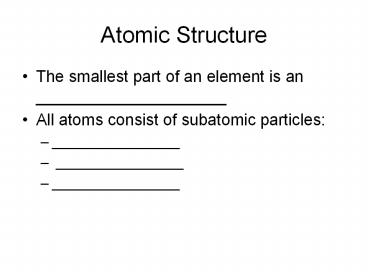Atomic Structure - PowerPoint PPT Presentation
1 / 32
Title: Atomic Structure
1
Atomic Structure
- The smallest part of an element is an
_____________________ - All atoms consist of subatomic particles
- ________________
- ________________
- ________________
2
Nucleus
- The ___________of the atom
- Contains ______________________of the atom
- ____________ and ____________ are found ______
the nucleus of an atom - Mass Number ___________________________
3
Protons
- _________________________________
- __________________________________
- 1 proton 1 atomic mass unit (amu)
- protons ________________________
4
Neutron
- _______________________________
- Found in the _______________
- 1 neutron 1 amu
- neutrons ____________________________
5
Electrons
- __________________________________
- Found in the ____________________
- Electrons have a very small mass, so we dont
even count it! - Electrons give atoms their _______________________
________ - Atoms are neutral so ____________________________
______
6
Shorthand Notation
7
Isotopes
- Atoms of the _________________with
________________________________.
- Nuclear symbol
- Hyphen notation ______________
Courtesy Christy Johannesson www.nisd.net/communic
ationsarts/pages/chem
8
Isotopes
Electrons
Nucleus
Electrons
Neutrons Protons Electrons
Neutrons Protons Electrons
Nucleus
9
6Li 7Li
Electrons
Electrons
Nucleus
Nucleus
Neutrons Protons Electrons
Neutrons Protons Electrons
10
Isotopes
- Chlorine-37
- atomic
- mass
- of protons
- of electrons
- of neutrons
Courtesy Christy Johannesson www.nisd.net/communic
ationsarts/pages/chem
11
Relative Atomic Mass
- 12C atom 1.992 10-23 g
- atomic mass unit (amu)
- 1 amu 1/12 the mass of a 12C atom
Neutron
- 1 p 1.007276 amu1 n 1.008665 amu1 e-
0.0005486 amu
Electrons
Nucleus
Proton
Nucleus
Carbon-12
Neutrons 6 Protons 6 Electrons 6
12
Average Atomic Mass
- weighted _________ of all ________
- on the Periodic Table
- round to _________ decimal places
Avg. Atomic Mass
(mass)() (mass)()
100
Courtesy Christy Johannesson www.nisd.net/communic
ationsarts/pages/chem
13
Calculating Average Atomic Mass
- You will be given the ____________and the
____________________(how common the isotope is in
nature) of the isotope
14
Average Atomic Mass
- EX Calculate the avg. atomic mass of oxygen if
its abundance in nature is 99.76 16O, 0.04 17O,
and 0.20 18O.
Avg. Atomic Mass
Courtesy Christy Johannesson www.nisd.net/communic
ationsarts/pages/chem
15
Example
- Carbon has 6 protons and 6 neutrons, what is
Carbons mass number? - An isotope of Carbon has 6 protons and 8
neutrons, what is carbons mass number? - Remember the number of __________ NEVER changes
for an element!
16
Example
- Carbon has 6 protons and 6 neutrons, what is
Carbons mass number? - C-12
- An isotope of Carbon has 6 protons and 8
neutrons, what is carbons mass number? - C-14
- Remember the number of protons NEVER changes for
an element!
17
Isotope Review
- Same element different number of
- __________________
- Different _________________
- Same _____________, therefore the same number of
protons and electrons
18
(No Transcript)
19
Atomic Structure
- ATOMS
- Differ by number of _____________
- IONS
- Differ by number of _____________
- ISOTOPES
- Differ by number of _____________
20
Electrons
- Electrons give elements their ____________________
______________ - The arrangement of the electrons will determine
how it _________ with other substances - Gain electron the atom becomes _______
(_______________) - Lose an electron the atom becomes ___________
(________________)
21
Electrons are found in the ______________
- The cloud has regions of space called energy
levels - The first energy level holds ____ electrons
- The second energy level holds _____ electrons.
- The third energy level holds ____ electrons
22
(No Transcript)
23
Valence Electrons
- Are found _______________________
- Dictate the _________ and ___________
________________ of an element - Use the periodic table to determine the number of
valence electrons.
24
Lewis Dot Diagram
- A way to illustrate the number of valence
electrons - Use _______for each valence electron
- Place the dot ______ each side of the symbol
before pairing the electrons - The __________ represents the nucleus plus all
the inner electrons for the element.
25
Examples
- H
- O
- N
- F
- Ne
26
Electrons and Light
- Electrons are normally in the ____________________
__________ - When the atom is given ___________ the electrons
move to the ___________ state. - When the electrons ________ this energy they fall
back to the ground state and emit
_______________. - Each element has a unique ________________________
___
27
(No Transcript)
28
(No Transcript)
29
Electromagnetic Spectrum
- Electromagnetic Radiation
- A broad range of energetic emissions
- made up of photons
- Photons bundles of energy
- Travel like waves
- Move at the speed of light 3.0 x 108 m/s
- Electromagnetic waves do not require a medium to
move
30
(No Transcript)
31
Parts of the wave
- Amplitude the height of the wave
- Wavelength the distance between the two
successive waves - Frequency the number of waves that pass a given
reference point per second
32
- Wavelength lamda in units of nm
- Frequency nu in units of 1/s or s-1
33
What is the difference between these waves?































